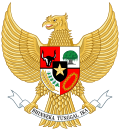Halim Cabinet Kabinet Halim | |
|---|---|
| 11th Cabinet of Indonesia | |
| 1950 | |
 | |
| Date formed | 21 January 1950 |
| Date dissolved | 6 September 1950 |
| People and organisations | |
| Head of state | Assaat Datuk Mudo |
| Head of government | Abdul Halim |
| No. of ministers | 13 ministers |
| History | |
| Predecessor | Susanto Cabinet |
| Successor | Natsir Cabinet |
| ||
|---|---|---|
Pre-independence Domestic policy Foreign policy Family Media and legacy | ||
The Halim Cabinet (Indonesian : Kabinet Halim) was the second and final cabinet of the Republic of Indonesia and it was one of 16 states in the United States of Indonesia. It served from 21 January until 15 August 1950, when the United States of Indonesia was dissolved and Indonesia once again became a unitary state.

